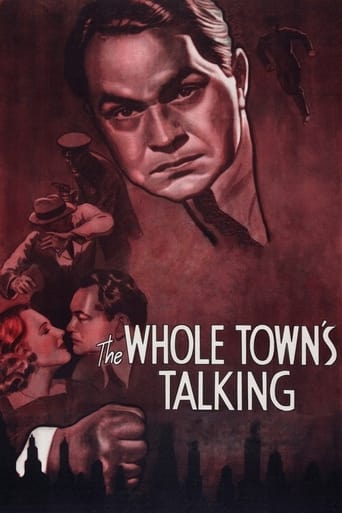dukeakasmudge
Soooo disappointing.I expected The Whole Town's Talking to be way better than what it was.It seemed like when something finally happens, the movie's almost over.I really had my hopes set high for this 1.When it was over, it was over.I didn't feel a thing.It wasn't Yay that was a great movie or even I'm so glad that's over, I just felt numb.When I 1st heard about The Whole Town's Talking which was a long time ago, I knew I just had to see it.After all this time I finally had a chance to watch it.I knew what time it was coming on & did everything I could to make sure I didn't miss it, only to be disappointed.I nodded off 3-4 times but kept myself awake.After watching this movie I should've just let myself fall asleep.Skip The Whole Town's talking & go see Larceny, Inc. It's WAY better & I promise, you won't be disappointed (Man, writing this review has been a struggle)
edwagreen
John Ford directed this 1935 comedy.Edward G. Robinson has an absolute field-day in a double role portraying a plain, introverted office worker who is mistaken for a major gangster.The fun begins when the gangster breaks out of jail and the usually hilarious Donald Meek identifies our poor worker. Jean Arthur co-stars as a fellow office worker.The confusion goes on and on with the gangster taking refuge at our worker's apartment. The latter has to get a letter from the police to hold onto so that he is not arrested. Later, he is taken in protective custody only to have the real thief take his place so that the latter can knock off someone in jail who has bad-mouthed him.The ending certainly shows that crime does not pay.
bkoganbing
I don't think there's anyone who's ever seen The Whole Town's Talking and doesn't believe this was a film intended for Frank Capra. The mere fact that the screenplay was co-written by Robert Riskin who won an Oscar together with Capra for It Happened One Night the year before should give ample indication. If Capra had a choice between this and Broadway Bill he chose wrong.Although this kind of comedy is not usually what is found in John Ford films, Ford does OK by it. I don't think he ever directed again anything that could be remotely classified as screwball comedy.Edward G. Robinson who would make his second and last appearance in a Ford film 34 years later in Cheyenne Autumn, plays a dual role. He plays Killer Mannion in the tradition he established as Little Caesar and also A.L. Jones a meek, mild mannered clerk a type Robinson would play later in Mr. Winkle Goes to War. Mannion's escaped from prison and there's a manhunt on for him, similar to the kind that was on for John Dillinger a year earlier. The police will simply shoot to kill. Bad luck for a guy that looks like Mannion and worse luck when Mannion finds out about his doppleganger and tries to make use of him.Robinson is fine in his dual performance, but the film was a milestone for Jean Arthur who plays Robinson's fellow employee and despite his being a milquetoast, she sees something in him. Up to this point Arthur had played a lot of ingénues and loyal wives to leading men. This is her first role in a screwball type comedy that she became known for, in fact what she's remembered for mostly. Of course a year later, Harry Cohn did team her with Frank Capra and they certainly made some cinematic history.My favorite two supporting parts are Etienne Girardot as Robinson's officious little office manager and Donald Meek another milquetoast who originally mistakenly turns in the clerk as the gangster and stays on the 'case.'Though he's not in his element John Ford serves a nice piece of entertainment.
theowinthrop
In 1933 Edward G. Robinson had finally essayed a comedy, THE LITTLE GIANT, with passable results. There he tackled the plot of a former racketeer discovering how unworthy the leaders of "good" society could actually be. The same type of a plot would be used again in Robinson's A SLIGHT CASE OF MURDER. But in 1935 Robinson was able to tackle a variant on gangster comedy. It was closer to Dr. Jeckyll and Mr. Hyde, as he played good guy wimp Arthur "Jonesy" Jones and public enemy # 1 Killer Mannion. Identical twins, they find they are drawn together by a physical chance. Mannion discovers that Jones looks so like him that he might be able to avoid police surveillance by switching places with Jones (who, for safety sake, won't try to stop him). Jones finds his job at jeopardy, his safety at jeopardy, and his girl friend "Bill" (Jean Arthur) possibly at jeopardy.There are some choice moments in the film - Ed Brophy, as the chief witness against Mannion, wandering away to his doom accompanied by "Jonesy" (or was it "Jonesy"), and the antics of two particularly dull comic cops (James Donlon and - surprisingly bright in the role - Arthur Hohl). Robinson as patsy and fiend is equally effective, particularly as Mannion decides the time has come to get rid of his harmless doppelganger and take over his place in the world. But will he succeed...or will "Jonesy's" ineptitude and timidity upset his plans.The director of the film was John Ford - it was his first film with either Robinson (who only showed up again in a supporting part in CHEYENNE AUTUMN)and his only one with Arthur. As such it reminds us of his film ARROWSMITH, which was his only film with Ronald Colman and Helen Hayes. In both cases he did well with his stars, and one wishes he had tried a second major film with Robinson, Arthur, Colman, and Hayes later on. But at least he did make these two films.




